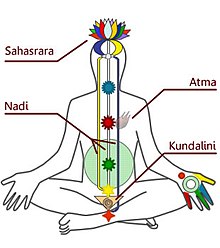
Back Kundalini AN كونداليني Arabic Kundalini BCL কুণ্ডলিনী Bengali/Bangla Kundalini Catalan Kundaliní Czech Kundalini Danish Kundalini German Kundalini Spanish کندالینی Persian

| Part of a series on | |
| Hindu philosophy | |
|---|---|
 | |
| Orthodox | |
|
|
|
| Heterodox | |
|
|
|
In Hinduism, kundalini (Sanskrit: कुण्डलिनी, romanized: kuṇḍalinī, lit. 'coiled snake', ⓘ) is a form of divine feminine energy (or Shakti) believed to be located at the base of the spine, in the muladhara. It is an important concept in Śhaiva Tantra, where it is believed to be a force or power associated with the divine feminine or the formless aspect of the Goddess. This energy in the body, when cultivated and awakened through tantric practice, is believed to lead to spiritual liberation. Kuṇḍalinī is associated with the goddess Parvati or Adi Parashakti, the supreme being in Shaktism, and with the goddesses Bhairavi and Kubjika.[1][2] The term, along with practices associated with it, was adopted into Hatha Yoga in the 9th century.[3] It has since then been adopted into other forms of Hinduism as well as modern spirituality and New Age thought.
Kuṇḍalinī awakenings are said to occur by a variety of methods. Many systems of yoga focus on awakening kuṇḍalinī through: meditation, pranayama, the practice of asana, and chanting of mantras.[4] Kundalini yoga is influenced by Shaktism and Tantra schools of Hinduism. It derives its name from its focus upon the awakening of kundalini energy through regular practice of mantra, Tantra, yantra, asanas or meditation.[4][5] When kundalini is awakened spontaneously or without guidance it can lead to kundalini syndrome which sometimes presents as psychosis.[6]
- ^ Frawley, David (February 2009). Inner Tantric Yoga: Working with the Universal Shakti: Secrets of Mantras, Deities and Meditation. Lotus Press. pp. 163–164. ISBN 978-0-940676-50-3.
- ^ Cite error: The named reference
Dyczkowskiwas invoked but never defined (see the help page). - ^ Mallinson, James. "Śāktism and Haṭhayoga." In: Goddess Traditions in Tantric Hinduism: History, Practice and Doctrine, edited by Bjarne Wernicke-Olesen London: Routledge, 2016. pp. 109–140.
- ^ a b "Spotlight on Kundalini Yoga". Yoga Journal. Retrieved 8 October 2013.
- ^ Swami Sivananda Radha, 2004, pp. 13, 15.
- ^ Sharma, M.; Dhankar, M.; Kumar, D. (2022). "Awakening of Kundalini Chakras Presenting as Psychosis—A Case Report". Indian Journal of Psychological Medicine. 44 (5): 526–528. doi:10.1177/02537176221082936. PMC 9460011. PMID 36157024.